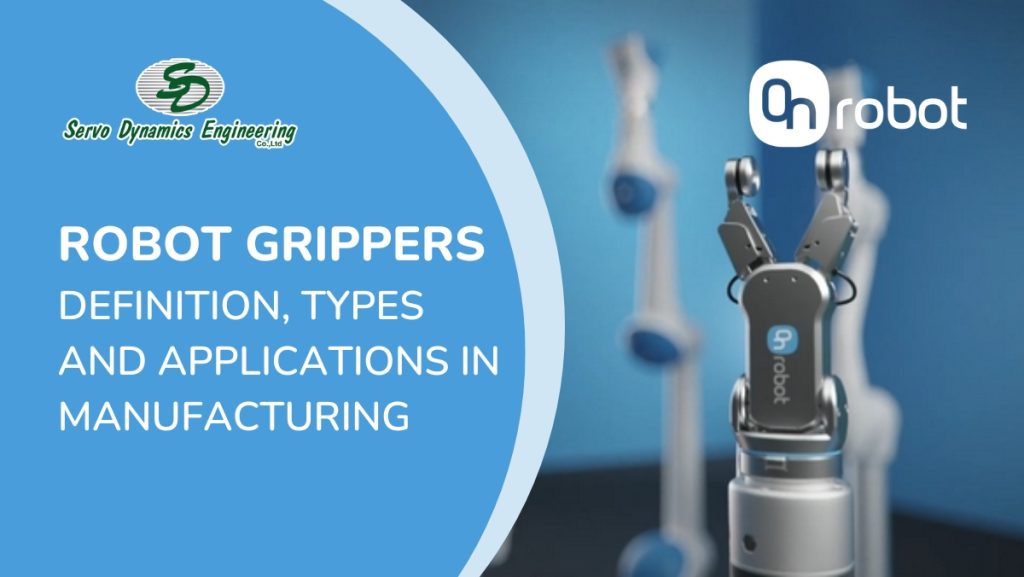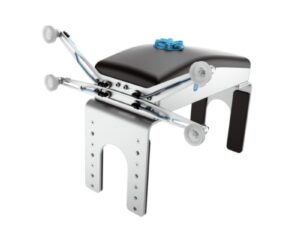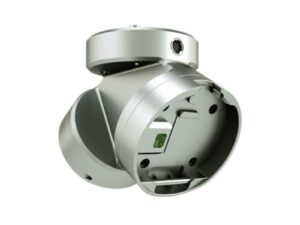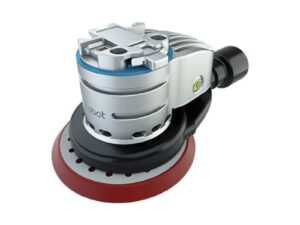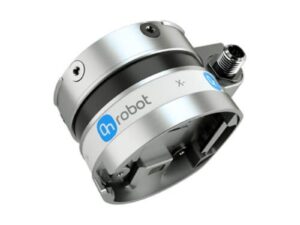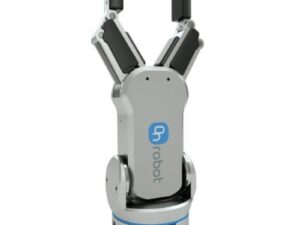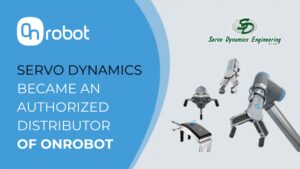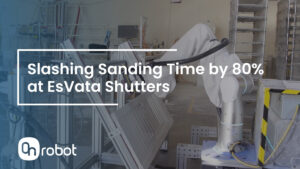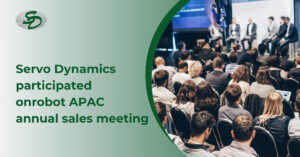Consulting, Industrial Automation, News, Solutions
What is a Robot Gripper? Types of Grippers Used in Manufacturing
What is a Robot Gripper?

In the simplest terms, grippers are devices that enable robots to pick up and hold objects. When combined with a collaborative (or ‘cobot’) industrial robot arm, grippers enable manufacturers to automate key processes, such as inspection, assembly, pick & place and machine tending.
It’s useful to think of grippers as similar to the human hand; they are positioned at the end of the arm and their abilities allow you to combine the strength of an arm with the dexterity of a hand. This combination opens up a huge range of possibilities for material handling with cobots, from stacking large boxes to handling tiny, delicate electronic components.
There are many different types of grippers available to use with UR cobots. Some grippers’ designs are just like human hands, complete with five fingers, but this isn’t always the case. There are grippers with two and three fingers, grippers shaped like claws, mechanical gripper types, grippers with large suction cups and even grippers that look like air-filled bags. With so many to choose from, it can be difficult to know which robot gripper types are best suited to which applications.
In this article, we will look at the most popular grippers in manufacturing. We’ll also summarise some of the options manufacturers have when selecting a gripper and we’ll explore some of the pros and cons of different robot gripper types for different applications.
What are the types of grippers?
Choosing a gripper for your cobot can seem like a daunting task, especially with so many different types of grippers in robotics and so much overlapping terminology.
However, for general purposes, grippers can be divided into 5 or 6main types, with each type being distinguished by the methods used to power and/or control the gripper itself.

Vacuum grippers
Vacuum grippers use the difference between atmospheric pressure and a vacuum to lift, hold and move objects. Typically, the vacuum (or ‘vacuum flow’) is generated by a miniature electromechanical pump or a compressed air-driven pump. The vacuum flow must be uninterrupted to ensure that your cobot can safely hold on to the object it has picked up.
Compressed air-type grippers produce between four and ten times more power than their electromechanical counterparts, which makes them a good fit for lifting heavy weights. However, electromechanical-driven vacuum grippers shine in applications requiring a high degree of mobility.
You will find vacuum grippers being used to automate a wide range of tasks, but one of the most popular applications for this type of gripper is packaging and palletizing.
For example, Norwegian meat producer Nortura deployed a UR10 cobot fitted with a vacuum gripper to optimize its palletizing operations.

This UR10 cobot is fitted with a Unigripper SMS 80-200 vacuum gripper, enabling it to lift and stack an average of 1,700 boxes per day.
DCL Logistics, a third-party logistics company based in the United States, fitted a UR10e cobot with a Piab piCOBOT vacuum gripper to handle picking and packing of items into boxes in the company’s fulfilment center.
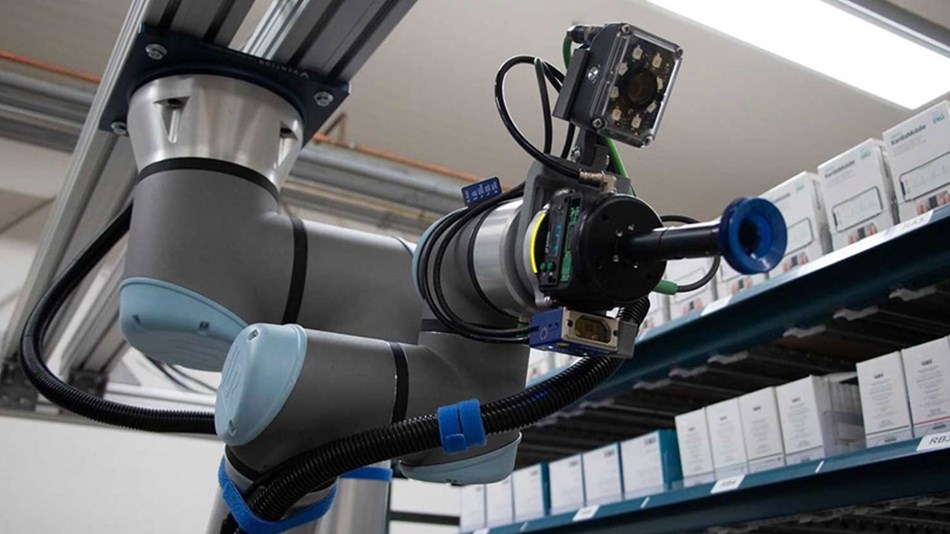
Using a UR10e fitted with a vacuum gripper for packing, DCL Logistics achieved a 500 percent efficiency increase, a 50 percent labor savings, three months ROI, and 100 percent order accuracy.
Advantages of vacuum grippers include the ability to handle many different types of items (even when those items are imperfectly positioned) and a lower price compared to other types of grippers. Disadvantages include added electricity costs to power compressed air or vacuum pumps and sensitivity to dusty conditions.
Pneumatic grippers
A pneumatic gripper uses compressed air and pistons to operate its ‘jaws’ (also known as ‘fingers’). Most commonly found in 2-finger and 3-finger configurations, pneumatic grippers are versatile tools that can be used in a wide range of applications.
For example, Toolcraft Inc, a small machine shop based in Washington, USA, chose the PHD PneuConnect pneumatic gripper to automate a tricky, three-operation machine tending task inside a CNC machine. Combined with a UR5e cobot (which provides repeatability down to 30 microns), the system was able to place parts in the CNC and when the CNC machine had finished its work, dip the finished part into a rinsing solution and pass it through an air jet before finally placing the washed and dried part on a rack for shipping.
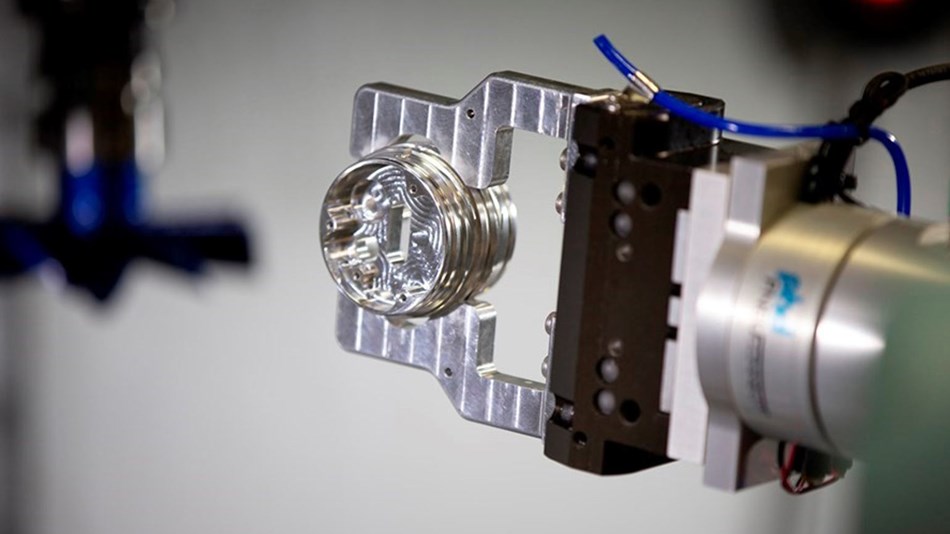
The main advantage of hydraulic grippers is their excellent gripping power, but with that power come several disadvantages, including the added complexity of handling oil, a pump, and a reservoir. Consequently, hydraulic grippers tend to be higher maintenance than other gripper types and they are also unsuitable for most cleanroom and many medical applications.
Electric grippers
Electric grippers are a popular choice for many cobot applications including machine tending and pick & place. While they don’t offer the same level of gripping power as hydraulic grippers, they are suitable for applications that require high speed and light/moderate gripping force. Electric grippers usually come in two-jaw and three-jaw configurations, with 3 jaw grippers often being chosen when round/cylindrical objects need to be handled.
For example, STAMIT, a machine tooling company based in the Czech Republic, used a 2-finger electric gripper from Robotiq and a UR10 cobot to take care of CNC machine tending tasks in its high mix production environment (4,000 differently tooled objects and 12 million parts total, each year).
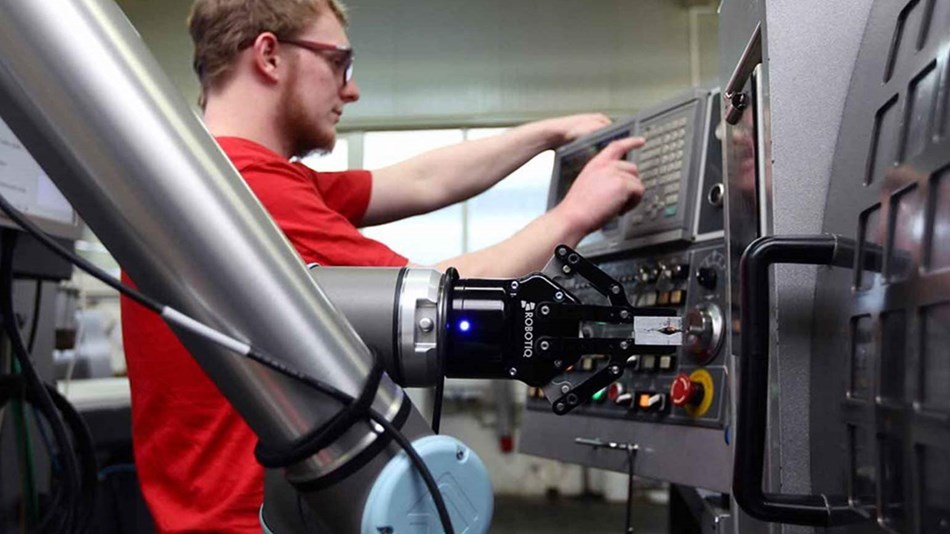
How to choose the right robotic gripper?
There are several factors to keep in mind when choosing a gripper, but the most important is to be led by the specific application you have in mind. Universal Robots makes this easy for you through the UR+ ecosystem, which provides a wide range of grippers specifically designed to handle the most common manufacturing tasks. Nevertheless, there are still some important questions to ask when selecting a gripper for your cobot:
- Will the gripper be handling a single item or a mix?
- What types of items –foodstuffs, electrical components, for example– will be handled?
- What shape are the items that you need the gripper to handle? (Flat, curved, irregular)
- Will the gripper be deployed in a cleanroom environment?
- Do you need data feedback from the gripper itself?
- What certifications should the gripper come with (e.g. food safe, IP7 compatability and so on.) What payload will the gripper need?
- Will the gripper need to operate in tight spaces?
What are the types of end effector?
The term ‘end effector’ (or ‘End-of-arm Tooling’ (EOAT)) is used to describe any device attached to the end of a robot arm. Grippers are one type of end effector, but there are many others. For example, a smart camera attached to the end of a robot arm could be used to help with inspection tasks. Or a welding tool end effector could be attached to a cobot and used to safely automate welding tasks.

The UR Olympus welding system with end-of-arm welding tools is ideal for simple welding applications.
Source: https://www.universal-robots.com/
Onrobot – Leading Gripping Solutions for CobotsOnrobot is a leading brand in providing gripping solutions and end-of-arm tools (EOAT) for collaborative robots (cobots). OnRobot’s innovative products — including grippers, sensors, and tool systems — are designed to boost productivity and efficiency across applications such as assembly, packaging, and material handling. Their user-friendly solutions enable quick integration with various robot platforms, making automation more accessible across industries ranging from manufacturing to logistics and beyond.
Explore Onrobot's Products
Servo Dynamics – Authorized Distributor of Onrobot in Vietnam
Learn More

 Tiếng Việt
Tiếng Việt
